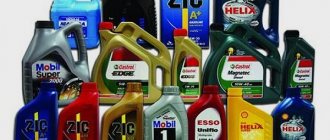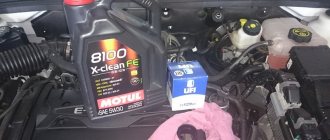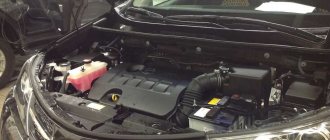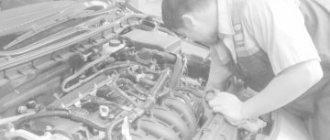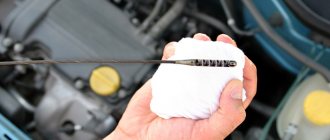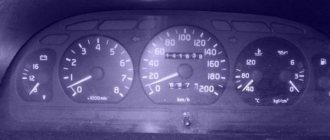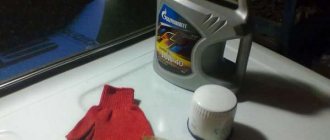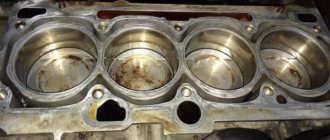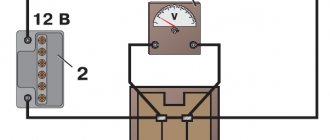Most car enthusiasts know that a lack of engine oil has a negative impact on engine life and can lead to serious damage. Most often, the crankshaft bearings rotate. Overfilling oil rarely leads to such serious consequences, but it can also cause a lot of problems. The most common problem will be increased pressure in the oil system and, as a result, failure of gaskets and seals. To put it simply, it will squeeze out the seals. This is a very annoying problem. After all, in order to replace an oil seal that costs 300-500 rubles, sometimes you have to pay 2-3 thousand for the work or spend half a day in the garage on this procedure.
Conditions and procedure for checking the oil level
To check the oil level in the lubrication system, prerequisites must be met. They are as follows:
- The vehicle must be located on a level surface.
- The engine must cool down.
- A standard probe should be used for measurement.
There are two notches on the dipstick, which indicate the most and least permissible filling levels. Checking the lubricant level is simple and involves several steps:
- The oil dipstick must be removed from the hole and wiped with a rag.
- Insert the dipstick all the way into the hole.
- Remove the dipstick from the hole and look at the oil mark. It should be between the notches, just below the top mark.
- If there is an oil mark below the minimum notch, it is necessary to add oil to the system.
- If there is an oil mark above the maximum notch, excess oil must be drained from the system.
Modern vehicles are largely equipped with on-board computers that indicate the presence and consumption of lubricant. You cannot always rely on the reliability of instruments. It is recommended to occasionally check the engine oil level yourself.
Preventive measures to control the required oil level
In order to avoid costly engine repairs and replacement of its parts, it is necessary to periodically perform the following procedures:
- It is worth regularly measuring the oil level using a dipstick. This must be done on a cold engine so that the oil completely drains from the walls. The correct result will depend on this;
- The required lubrication level should be in the region of ¾ of the maximum;
- Used cars are especially susceptible to negative consequences from a lack or excess of oil, so used cars should be checked much more often than new ones;
- It is better to always have special tools on hand for pumping out unnecessary oil in the form of a pump or a regular medical syringe. You may also need wrenches to unscrew the drain plug if necessary.
Conclusion
At the end of this article, I would like to remind you of the importance of maintaining the required oil level inside your car’s engine. What to do if you overfill the engine with oil? What if the engine oil level has increased? The text provided comprehensive answers to these and other questions in this area. If you own a car with decent mileage, then you should pay special attention to the amount of lubricant in the heart of the vehicle.
Timely detection of the problem and its elimination in the shortest possible time will allow you to protect your wallet from unnecessary spending. The oil level may increase during a routine replacement of used lubricant at a cheap service center, so you should only contact an authorized dealer for this procedure.
Why is there more oil than normal?
There are several reasons why it is possible to pour oil into the engine lubrication system. This can happen as a result of technical features of the lubrication system or the driver’s personal inattention. The main reasons are:
- The presence of another working fluid in the oil. The volume may increase if coolant enters the lubrication system through the filler neck or dipstick hole. Another way for liquid to enter the lubrication system can be a broken gasket under the cylinder head.
- Incorrect oil change in the lubrication system. When you change the oil yourself and drain it, 0.2 to 0.3 liters of oil remains in the lubrication system. Its volume depends on the design features of the vehicle. Filling with new oil can be carried out in accordance with the manufacturer's recommendations, without taking into account the oil that remains in the car after draining the old one.
- Oil temperature is not taken into account. When heated, the oil expands in volume. The oil mark on the dipstick should be between the upper and lower notches. Filling the lubrication system to the maximum level may lead to an increase in the oil level after its thermal expansion.
- Broken compression. It occurs as a result of coke formation after carbon deposits or debris entering the crankcase.
- Clogged valve. It is necessary to separate the engine crankcase from the atmosphere. If the valve becomes clogged, a dangerous level of pressure is created and the volume of lubricant increases. It is necessary to clean the ventilation system from dirt.
Signs of overflow
You can determine that the amount of lubricant in a car is high enough based on several signs. These include:
- Starting the power plant occurs with difficulty. Resistance to rotation of the crankshaft will be created by excess oil fluid poured into the crankcase. As a result of resistance, the number of revolutions decreases.
- Oil leakage. After starting the power plant, it can overflow from the filler neck, through the sealing elements or docking joints of the engine housing.
- Presence of thick white smoke from the exhaust pipe. This can happen if the seal is broken due to pressure in the oil system and coolant enters the lubrication system.
If these signs appear, it is necessary to take measures to eliminate them. In order to prevent a decrease in the performance of the machine, you need to know the dangers of a significant overflow of oil into the engine.
What causes overflow
The most common action that causes a high oil level in the system is poor performance of the oil change procedure. The mechanic may not completely drain the used lubricant from the engine. Also, oil residues may simply remain on the inner walls of the engine if the engine was not well warmed up before the replacement procedure. Up to half a liter of lubricant may remain inside.
The level of fuel and lubricants in the engine can be increased specifically by the car enthusiast himself. There is an opinion that a slight overestimation of the volume of cheap oil will have a beneficial effect on its lubricating properties in the future. This approach is deeply misleading and does not stand up to criticism.
It is worth noting that you cannot mix semi-synthetics with synthetics, and the labeling of motor oils must be carefully studied before it gets inside the engine.
The dangers of overflowing oil into the engine were described above, but this situation can be corrected very easily, the main thing is to detect the increased volume of lubricant in time.
Basic steps to eliminate excess fuel:
- The first step is to simply dismantle the oil filter until the excess amount of lubricating fluid flows out through the hole;
- If the oil level is significantly higher than normal, then the excess can be removed through the drain hole by simply unscrewing the plug;
- You can also use a regular medical syringe along with a rubber tube from a dropper. An increased volume of oil can be pumped out from the hole into which the dipstick is inserted.
Important! All operations to remove excess lubricant can only be performed on a completely cooled engine.
Consequences of overflow
Overfilling the engine with oil has consequences that can affect the performance of the equipment. These include:
- The formation of deposits in internal combustion engine cylinders as a result of the combustion of a large amount of oil. Carbon deposits on the internal parts negatively affect the hollow piston of the engine, reducing its performance and service life.
- Increased lubricant consumption and temperature. Excessive oil causes the crankshaft to foam, causing the oil temperature and flow rate to increase.
- Increased fuel consumption. The reason for high fuel consumption lies in the difficulty of starting the power plant, especially when a diesel unit is installed. The driver feels that the engine is losing power and presses the fuel pedal. As a result of such operation, fuel consumption increases.
- Additional load on the oil pump and filter. If there is excess lubrication, the pressure in the oil system increases and the load on all components of the system increases. Operation in high pressure mode may result in premature failure of the oil filter and pump. Accordingly, significant financial costs for their restoration.
- Air intake into hydraulic compensators. Excess oil will foam the crankshaft, resulting in reduced lubricant uniformity. This will cause airing of the hydraulic compensators and increase the load on them and on the gas distribution mechanism.
- Carbon deposits on spark plugs. With excess oil and high pressure, a significant layer of carbon deposits forms on the spark plugs. As a result, the performance of the spark plugs decreases, the injector produces pulsed fuel emissions and the spark plugs are flooded. When filling spark plugs, diesel or gasoline will escape along with the oil film through the piston rings into the lubrication system.
- Muffler clogged. The increased volume of combustion elements settles in the muffler. This is dangerous because the power plant loses power. The muffler's service life is reduced.
- Increased amount of exhaust gases and their toxicity. If there is excess lubricant, the volume of its combustion increases. As a result, the amount of exhaust gases increases and their quality deteriorates. The release of toxic substances into the environment is increasing. This is less dangerous in the summer, and unsafe in the winter, especially in the garage.
- Failure of sealing elements. If there is excess lubricant, it quickly heats up above normal and excess pressure is created in the engine. As a result of this, oil seals and gaskets may become deformed and fail. The consequence will be a drop in power of the power plant and leakage of lubricant.
Changing the oil in the transfer case of a Chevrolet Niva
Chevrolet Nivas leave the assembly line with a mineral transmission, which has a viscosity of SAE 75W-90, 80W-85, 80W-90 and complies with the API GL4 or GL4/GL5 standard.
However, according to the observations of car owners, replacing mineral water with synthetics or semi-synthetics has a positive effect on the operation of the transmission:
- The gearbox is quieter.
- There is less vibration when moving.
- Makes gear shifting easier in winter.
Any vehicle needs technical support. The equipment will work successfully only in cases where all mechanisms function without failure. Any motorist knows that the engine will not work if the appropriate motor oil is not poured into it in a timely manner. However, not only the car engine, but also the gearbox needs oil fluid.
The process of changing the oil poured into a Chevrolet Niva transmission is not complicated, however, it is certainly necessary to prepare for it and arm yourself with the necessary theoretical knowledge. Many motorists believe that it is best to turn to professionals who will perform such tasks quickly and with the highest quality. This is partly true, but in order to save money, you should not contact a service station; it is better to do everything yourself. We will help you understand the intricacies of the procedure.
According to the regulations, you need to fill in from 3.5 to 3.7 liters of oil, and for refueling it is recommended to buy a 4-liter canister. Please note that after refueling you may have some oil left over - these residues can be poured into the machine during the next refueling, or used to top up during operation, but first you need to make sure that the expiration date has not expired.
Selecting oil and filter
How much oil should I pour?
Tools and materials
What will happen if you don't change?
When selecting motor oil for a car’s power unit, the owner must understand that not only the period between replacements, but also the operational criteria of the internal combustion engine will depend on the quality of the liquid filled. All this leads to the fact that when choosing a lubricant, you should not save, as this is often impractical.
The internal combustion engine of the Chevrolet Niva, according to the manufacturer's regulations, is a high-tech unit and meets the Euro-4 standard, which means filling with oil based on synthetic materials of the appropriate quality. From the factory, the Niva Chevrolet engine is filled with motor oil with a viscosity coefficient of 5W30, which meets ACEA class A2 and API standard SL/CF criteria.
Accordingly, when choosing a replacement engine oil, it is necessary to give preference to products with quality standards declared by the automaker, while the viscosity coefficient may vary depending on the prevailing operating conditions of the vehicle and the temperature range in which it is used.
API acceptable criteria for filling into internal combustion engines are the oil markings SG, SH and SJ. As for the priority brand of products, car owners most often use oil from Lukoil, Shell and Mobile for filling. However, the consumer can give preference to any of the world’s well-established suppliers of lubricants and combustible materials, choosing from their assortment a product with quality criteria that meets the standards described above.
When purchasing oil, it is important to take a responsible approach to choosing a point of sale; certified auto stores are preferred, as they protect the consumer as much as possible from purchasing counterfeit products.
So, to clarify the situation regarding the level of the main motor fluid, you need to consider why it is dangerous and what are the original sources of the problem.
If the lubrication level is high, it is necessary to pay attention to the main reasons that lead to this problem.
Also interesting: Changing the oil in a Niva Chevrolet engine
Ways to eliminate overflow
To avoid the unpleasant consequences of overfilling, it is necessary to carry out timely measures to pump out excess oil. It all depends on how much excess grease was poured into the car.
In the case where the oil is 200-300 grams above the permissible level in the engine, the problem can be solved on the spot. To do this, it is enough to remove the oil filter from the lubrication system and place it on a stand so that the lubricant can drain. After the lubricant has drained, the filter must be placed in its place. In cases where the overflow is significant, there are several ways to solve this issue.
The first method involves using the capabilities of a service station. Many of them practice express oil changes or its selection from the lubrication system. If there is such an enterprise nearby, it is recommended to contact specialists. For a small fee, they can pump out excess lubricant using special equipment using special vacuum equipment.
The second method involves pumping out the oil lubricant yourself through the filler neck. To pump out lubricating fluid, you must have an oil container and a hose, preferably with a vacuum bulb. Pumping work includes the following activities:
- It is necessary to lift the hood and remove the cap from the oil filler neck.
- One end of the hose must be inserted into the filler neck, and the other end must be directed into an oil container.
- Using a vacuum bulb on the hose, pump out the required amount of lubricant. When using a regular hose without a vacuum bulb, you need to use your mouth in the drain hole to perform 2-3 short suctions of air and drain the lubricant. Do not allow oily liquid to enter the oral cavity.
- Check the oil volume using a dipstick.
- Close the filler neck and hood.
Replacement instructions
- We warm up the engine to 45-50 degrees. Warm oil has better fluidity and will drain better from the engine during a complete replacement. Our task is to remove as much as possible the old dirty and used fluid that no longer has useful properties from the engine and fill it with new one. If a lot of old dirty oil remains in the crankcase, it will be swept away with the new one and will worsen its beneficial properties. Warm up the engine for 5-7 minutes before starting, this will be sufficient.
- For easy access to the drain plug (and in some models the oil filter is also attached from the bottom) and the bottom of the car as a whole, you need to jack it up or drive into an inspection hole (the best option). Also, some models may have engine crankcase “protection” installed.
- We open air access to the crankcase by unscrewing the filler cap and dipstick.
- Place a large container (equal to the amount of oil being poured).
- Unscrew the drain plug with a wrench. Sometimes the drain plug is made like a regular “bolt” under an open-end wrench, and sometimes it can be unscrewed using a four- or hexagon. Don't forget to wear protective gloves, the oil will most likely wake you up warm, but you need to be careful.
- We wait about 10-15 minutes until the waste flows into a basin or cut-off plastic canister.
- Optional but very effective! Flushing the engine with a special liquid is not included in the maintenance regulations and is not mandatory - but. By getting a little confused, you will be much better at flushing out the old, black oil from the engine. In this case, wash with the old oil filter for 5-10 minutes. You will be surprised at the black oil that comes out with this liquid. This liquid is very easy to use. A detailed description should appear on the flushing fluid label.
- Changing the sedum filter. In some models, it is not the filter itself or the filter element (usually yellow) that is changed. Don’t forget to “impregnate” the filter with fresh oil. Pour approximately 50-100 g directly into the filter. These simple manipulations will help avoid the so-called “oil starvation” of the engine in the first seconds of operation. Also remember to lubricate the rubber O-ring before installation.
- Fill in new oil. Having made sure that the drain plug is screwed in and a new oil filter is installed, we can begin to fill in new oil using the dipstick as a guide. The level should be between the minimum and maximum marks. Also, you need to remember that after the first start of the engine, some oil will leave and the level will drop.
- In the future, when the engine is running, the oil level will probably change; be careful during the first few days of operation. Recheck the oil level using the dipstick after the first start.
Also interesting: How to check the generator on your own: checking the generator without removing it from the car, relay regulator, diode bridge
